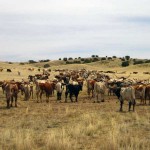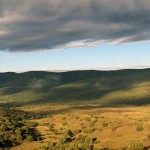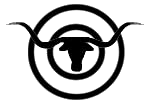
Our Longhorns move in large groups, but there will always be stragglers to locate and bring in.
Times have changed — Good grazing hasn’t
We still graze for soil health. We have a small farm – about 100 acres- in Tennessee and raise grass-fed beef. We expect to expand to include free-range chickens and goats. We have a great family running the place so Doug and I are free to travel. Lessons we have learned about herding, pasture rotation, and natural food are still in full force on our Green River Farm in Middle Tennessee.
Where traditional cattle ranching tends to focus on the land simply as a place to grow cattle, with sustainable ranching the land is an end in itself. We manage the grass as much as we manage the cattle…so in a way, what we are growing is nature! We are regular old cowboys and cowgirls, but we’ve learned from the land – mostly through trial and error – to be scientists and mathematicians as well.
One of the things we’ve learned is how we can maintain our herd of Texas Longhorn steers and not only not have a negative impact on the land, but actually leave it in better condition than it was to begin with. Traditional ranching dictates you leave your herd alone in large pastures for long periods. We have found that by doing exactly the opposite—moving them frequently through smaller, controlled areas—we can achieve the best results with our cattle and with the land as well.
Most breeds of cattle could probably be used in a sustainable ranching environment. We like our Longhorns because of their hardiness and their willingness to go anywhere and eat anything. The Double Circle Ranch no longer sells its cattle, but if we wanted to sell beef or raise calves, the rotational grazing and other sustainable practices we have adopted would be perfectly suited to that as well. We believe sustainable ranching will become less a novelty and more a necessity in the coming years, and we are proud to be among the first to fully embrace it. In our experience, we’ve found you don’t have to choose between what is best for the herd (or the business) and what is best for the land…it’s not necessarily the easiest way to ranch, but if you’re willing to put in the effort and learn to use your herd as a sort of ecological tool, the land and the herd can both thrive.
Grasses

A bird's-eye-view of the Double Circle Ranch range land.
In a dry environment, plants rely on the concentrated impact of animal herds to help them decompose and thus return their energy to the soil. Without that impact, the nutrient cycle weakens, soil dries out and the whole ecosystem suffers and becomes less hospitable to wildlife. When we concentrate a large herd in a small area, our steers break down the plant material correctly and thus stimulate the system to regenerate itself. Because they are grouped densely, the cattle eat not just the good grass but all the grass…and then we move them, and they will not return to the pasture until the grass has repaired itself.
Soil & Nutrients
In close quarters, cattle walk not just on well-worn paths but everywhere. They trample their own manure, sending its nutrients back into the ground. Their hooves break up dead plants, helping them decompose. As their hoof prints collect water and plant litter they become moist, protected areas in which seeds can germinate. And the steers’ non-selective grazing sets all the plants back to square one, which gives slower-growing perennial grasses a chance to compete with annual invaders.
Water
On bare, hard dirt, water just rolls away: in order to retain water, there has to be something on the land to hold a raindrop when it hits. Let a couple hundred cattle tromple around a few days, and their hooves roughen the soil enough that it will catch rain. With their natural movement, the cattle break dead plants into stems and twigs that lie on the ground and act like so many little dams. Best of all, with their manure as fertilizer and their hoof prints as planting pots, cattle encourage the growth of new plants – the best tool there is for retaining water on the land.
Fire
You’ve heard of preventive burning, where certain tracts of land are intentionally burned in order to avoid becoming part of an out-of-control wildfire? We can achieve a similar result with the cattle. If there is an area that needs to be burned but for whatever reason cannot be, we can hold our cattle in there until the dry undergrowth has been removed, lessening the risk of fire. Simultaneously, our steers are breaking up the soil with their hooves so it can better retain what little water there may be, and they are depositing an average of about 12 pounds of urine and manure per steer, per day on it to boost the quality of its nutrients, soils and grasses.


